This post was intended for the FFVIII Remaster OT, but it grew in scope to the point where I decided to make it its own thread. It is an exploration of some of the themes and interpretations surrounding Ultimecia, who is a fascinating character and one of my favorite villains in any game. The point of the thread isn't to "sell" any one interpretation, but rather to just demonstrate how much thematic material is available for "reading" the character, and by extension how impressive the storytelling in the game is.

Getting a sense of what exactly lies at the core of Ultimecia's character is tricky because so much of it is deliberately left ambiguous. We can surmise from her dialogue in the final battle that she, at one point, had some semblance of a childhood. Over the course of her life she was hunted and ostracized, and has grown obsessed with the concept of suppressing time altogether, leaving the world in a miasmic state where nothing happens. All time compressed, and to the extent that objects rely on time's flow to produce causal effects, all existence denied.
Much of the symbolism around Ultimecia supports a fascinating interpretation of her character: that her hatred and frustration is driven by having never been able to act as a motherly figure towards others. In this context, given the fact that two of the core themes of the game are time and love, it is interesting to read Ultimecia as a foil to Edea. Edea, expressly a "Matron," has raised and supported many children at the orphanage, leaving a significant and positive impression on their lives; Ultimecia's life has been marked by violence and alienation, and she has failed both to express love and to reap the joys of love growing into beautiful things over the course of time.
There are several small but suggestive symbols that hint at this frustration, though I'll save the biggest and most disturbing one for last. Our jumping-off point will be a discussion of something that has been the subject of some controversy over the years - Ultimecia's name.
The name "Ultimecia" is actually a bit of a localization flourish, probably one to suggest greater power or make her sound more imposing. In the original Japanese her name is アルティミシア, which translates phonetically as "a ru ti mi shi a." As such, there is a very good argument that Ultimecia's name should have been localized as something like "Artemisia"; this is indeed the approach that translators in most of the other romance languages took when localizing her name. More to the point though, the English localization loses something that is rather apparent in the other localizations, and something that will immediately stick out to anyone familiar with Greek mythology: her name is a derivative of the name Artemis.
This connection is by no means a coincidence. Several of the things very closely associated with the Greek goddess Artemis appear repeatedly in FFVIII, oftentimes in direct relation to Ultimecia. Artemis' most important functions were her roles as Goddess of the Moon, of the Hunt, and of Childbirth (though she, herself, was a virgin). In her role as Goddess of the Hunt, she was often viewed as a "mistress of the woods" who spent her time alone in nature and amongst the animals, eschewing the typical female role as a mother or wife within the Greek household. The parallels to Ultimecia, who exists as a Sorceress and as a woman alone and beyond the accepted social conventions of society in her time, are clear; and the Moon itself plays an important role in FFVIII, both as a plot point and as a recurring symbol associated with the Sorceresses. As it pertains to Ultimecia specifically, I want to draw special attention to this shot which connects her to the Moon, and indeed occurs the first time she is ever directly shown in the game:
The above clip starts with Ultimecia's introduction at the end of the game; a celestial body (let's not call it the Moon quite yet) first shines red, then the clouds part to reveal it fully as it illuminates her throne room. It continues to loom ominously above her throughout her speech to the SeeDs:
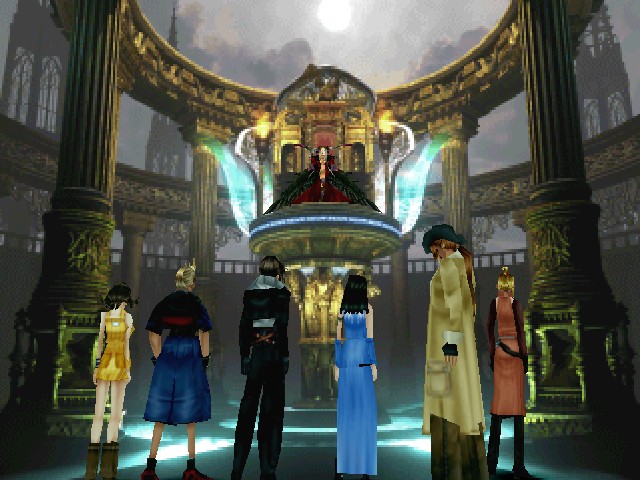
Now the big question here is whether that's the Moon or the Sun. I won't delve entirely into that debate (though I will say that a Red Moon is a recurring motif in the Final Fantasy series, and that the object conspicuously shines red before fading into view), so I'll just summarize what I believe: that it is the Moon shining as if it were the Sun, visually illustrating a world in which Ultimecia wields absolute power. In that respect, if we accept that there is a substantive link between the Moon and Ultimecia/"Artemisia," then its position of eminence above her, and its luminance, is a symbol of her authority and power as she prepares to confront the SeeDs.
This association is important because the Moon itself is also, more importantly, a symbol of motherly influence. Despite never expressly touching the Earth, it exerts a massive, indirect influence on it through maintaining a close orbit that galvanizes the ocean's tides. In times of darkness (i.e. night) it provides light and comfort. It is always there even when it is unseen. This symbolism is further reinforced by the lighthouse area of Edea's Orphanage, which draws a direct connection not only between matron Edea and the Moon, but also between both of those and the function of a lighthouse in guiding wayward vessels:
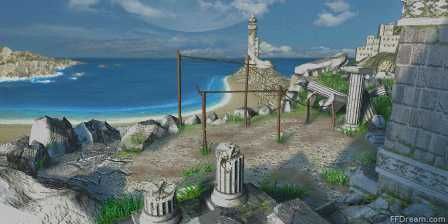
Note that the Moon in this shot even touches the lighthouse exactly where its light shines from. All of these are qualities of motherly love that are perverted by the Sorceresses and the Lunar Cry; the Moon instead becomes a source of pain, a looming threat that occasionally unleashes a horde of monsters that wreck havoc on the Earth and only make the problems there even worse. It is in this capacity, as a symbol co-opted by Ultimecia and her twisted plan, that the imagery of the Moon appears throughout most of the game; it is effectively Ultimecia's stand-in, a reminder that she is in control of events as they unfold. When she at last appears, it shines above her menacingly.
The close relationship between Artemis, Ultimecia, and the Moon works in tandem with other symbols, suggesting that Artemis' final major role - as a virgin Goddess of Childbirth - is also present in Ultimecia. As I mentioned earlier, Ultimecia may be unbearably frustrated that she was never a motherly figure, whether symbolically or literally. She was robbed of that experience, of nurturing, cultivating, and loving others, by the circumstances of her birth. We know from Edea's discussion of Sorceresses that they possess a consuming desire to pass on their powers, a desire that can even outright prevent them from dying until they have done so. In both a literal and figurative sense, the people of Ultimecia's world robbed her of the opportunity to leave anything of herself behind. She has no successor, a virgin Goddess of Childbirth who the world prevented from becoming what Edea is - a "matron."
In this context, what is time compression? It's always been a strange goal relative to other Final Fantasy villains. What does it accomplish to squeeze all of time together, to eliminate causality and to have every instance of oneself exist at the same time? Perhaps Ultimecia is a broken, lonely woman so frustrated in her desire for meaningful relationships as a motherly figure - to have children/successors to cultivate through motherly care - that her final, desperate plan is to become her own mother. It is a perfect loop of unchanging affection; compress time and remain forever young, forever old, forever loving herself as a mother, forever loving herself as a child. Social relationships are immaterial; there is nothing except an infinitude of her own selves, loving and being loved eternally. Perhaps it is a plan born from the deepest despairs in her heart, a dark inner fury imbued with sorcery that even she doesn't fully comprehend. Perhaps her rage has so engulfed her that she hastens blindly towards this goal, even knowing deep down it will destroy the very fabric of reality.
These suggestions lead to the last and most disturbing imagery: her final form at the end of the game.
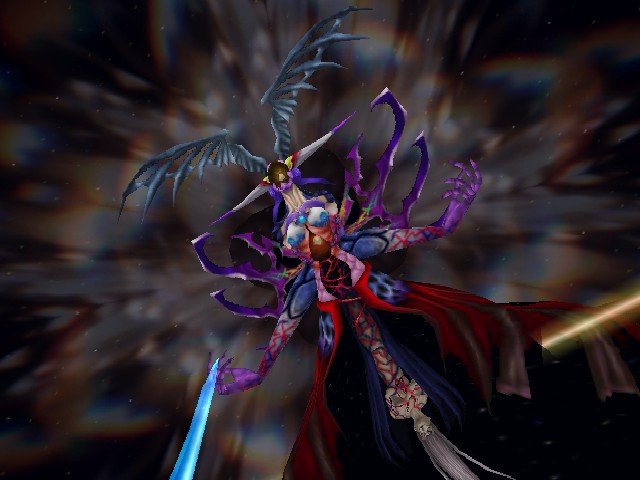
Here, Ultimecia is fully dissociated into two selves: an upper, demonic half, perhaps one that represents all of her despair and suffering, physically manifesting through the power of her sorcery; and a lower half, helpless and passive, that represents all that remains of her inner self, unconsumed by that hatred and frustration. The design also features an important element that can be difficult to see: time and space is being sucked past the hanging lower Ultimecia and into the upper one's dress, as you can most clearly observe when she has Meteor cast on her (I've timestamped the video below to where its most apparent):
This creature, in its totality, is Ultimecia as she exists now, and it is a stunning allegory representing her psyche and the tragedy of her existence. As she hangs limply beneath this abomination of sorcery above her, time and space flow past her - and she touches nothing. Time flows on and her life expands as a wasteland of emptiness. She has no bonds, no successors, no children (not necessarily literal, biological children; rather, just younger individuals whom she has supported and loved). She never was in a position where she even could have those things. All of that time, all of that life, flows by her, empty and unyielding, as she floats helplessly, all of it feeding up into the most disturbing imagery of all:
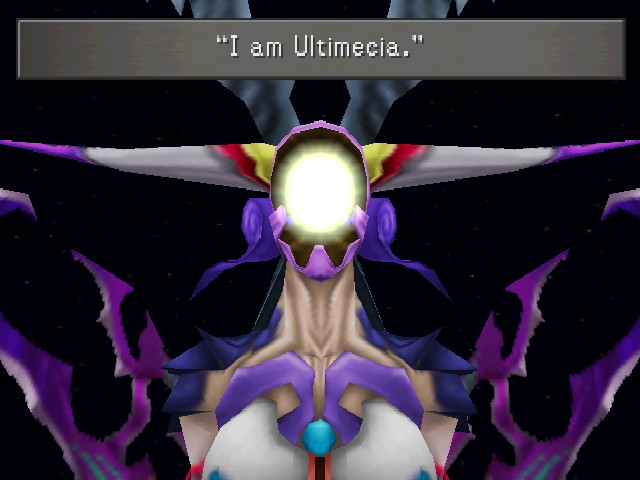
It is her nightmare and, in an uncomfortable way, the nightmare that we all share as humans who want to leave something of ourselves behind. It is the "No Face" - the symbol of never having existed. Never having expressed, or been expressed to by someone else in a social relationship. It is an existential, terrifying emptiness visually represented on the part of the body where there should be the most clear sense of self. It devours time and space from below, and it produces nothing. There is no point to all the time and the space it takes in. It is not a person, just a thing that has no function, no one loves it, it loves nobody, it isn't even human. It wears the twisted garb of the Sorceress because it is a manifestation of Ultimecia as she sees herself - as nothing, a mere shell of a vessel that navigated through a pointless and meaningless life. She is not the only one who is terrified by this existence; the same exact imagery reappears later with Squall (I will actually spoiler tag this because some may find it disturbing):
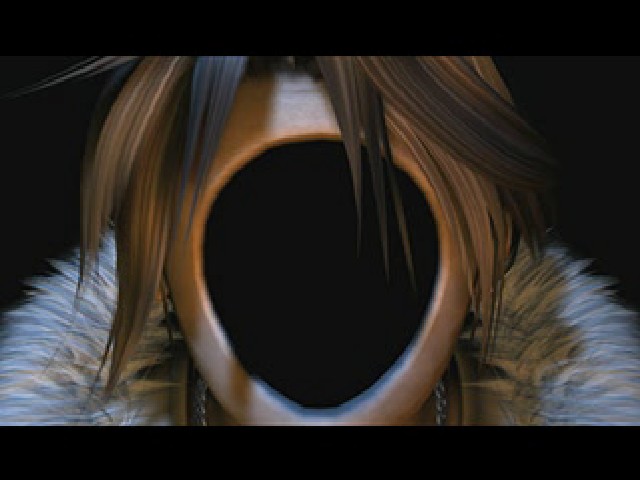
Needless to say, Ultimecia has been dealt a terrible and tragic fate. But FFVIII, despite its heavier themes, is a hopeful story. It's a story of conquering despair and alienation, of leaving a mark on those around you. And I believe Ultimecia does just that. It all lies in these famous words, that every FFVIII fan will immediately recognize, and some may even know by heart:
""I am Ultimecia. Time shall compress… …All existence denied."
"Reflect on your… Childhood…"
"Your sensation… Your words… Your emotions…"
"Time… It will not wait…"
"No matter… …how hard you hold on. It escapes you…"
"And…""
And for reference, here is a more literal translation from the original Japanese (sourced from this blog):
""I am Ultimecia. I will compress all time and refute all existence."
"Have you remembered something?
Something from your childhood
A sensation
The words from back then
The emotions from back then
As you become an adult
You leave something behind, throw something away
Time will not wait for you
Even if you cling to it
It slips away the instant you open your hands
And…""
These lines are spoken by Ultimecia during the final battle of the game, and have been the subject of a lot of interpretations and theories over the years. The first line "Time shall compress... ...All existence denied" even seems to be at direct odds with the sentiments expressed in the rest of the dialogue.
And that's because, perhaps, it is. What is not clear in the English translations is that, after the first line, the dialogue changes register and becomes more formal - implying that there are two different speakers, one who speaks the first line and one who speaks, in a totally different register/tone, the rest of them. While the first line is also spoken with an extreme close up of the "No Face" upper Ultimecia, the remaining lines are spoken from a camera angle where the entirety of Ultimecia's body is visible - including the lower, "true" Ultimecia. The lower Ultimecia is also a separate, selectable target, though it has no attacks and performs no actions.
As the SeeDs damage and weaken the demonic Sorceress Ultimecia above, the true Ultimecia below breaks through and helps them. Every line past the first belongs to her. These words are her one, final act of redemption, in which she tells the children how to survive. How to return to where they came, and not be swallowed up in the vast expanse of time.
Reflect on your childhood. Your sensations, your words...your emotions. Something in there is lost when you become an adult - find that, cling to it, not to time itself. It is the connections, the sensations, the bonds formed with others within time that will save you. Ultimecia knows this because these are the things she never had, and that she vainly sought to destroy time itself to acquire. She urges them to remember those child-like sensations, to use them and their purity to cut through the darkness and find their way back to one another. Here, at the very end of things, she becomes a "matron" at last, even if it means saving them from herself. It is her repudiation of the monster she has become. She guides them gently in the darkness when they most need it - like a lighthouse, or like the moon in a deep night. She shows them the way.
In both of the English translations and in the original Japanese, Ultimecia's final sentence remains unfinished. It is a conjunction indicating that she is about to say something else, or that something else is about to happen. Despite being a single, brief word, it is the most touching symbol of her redemption - because everything that follows is what happens after the "And." She has left something behind at last, something that remains unfinished by her: it is the fate of the SeeDs, who heed her words and cut through the darkness of time to reunite with one another. Ultimecia, too, hurdles through time, landing beside Squall and passing her powers on to Edea. Her legacy, in a strange way, is the survival of the SeeDs who will ultimately destroy her. By breaking through her hatred, her frustration, and the influence of her own inherited and terrible sorcery, she has finally acted as a mother would and helped these children survive. She has conquered herself. The symbolism is profound; it is at this exact moment that she finally passes her powers on to Edea, and dies. She has become Edea, both in the context of the game's narrative, and figuratively; she has at last become a force of that motherly good that Edea represents.
Which brings us to the final shot of the game, one that puts a cap on these themes perfectly:
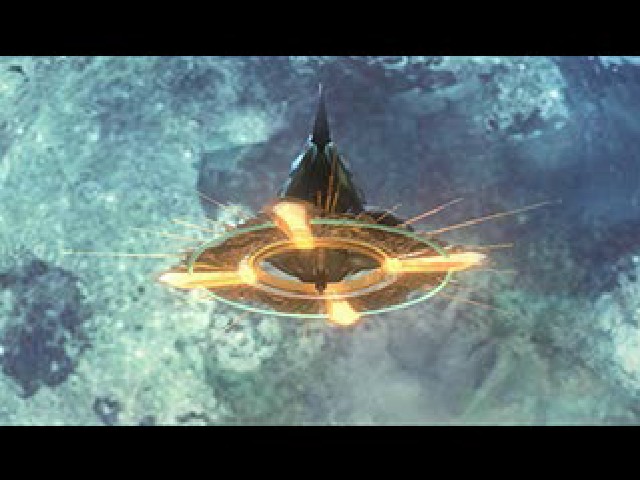
In the background the Moon looms large, and you can distinctly see the silhouette of Griever within its landscape (its fangs are above and below the Garden's rotating disc on the left side). What was the last thing that happened with Griever? Well, Ultimecia junctioned it to herself. It was the one direct link she had to these children whom, at the very end, she guided towards victory and survival. The Moon, her symbol, looks down on the Garden that she caused to exist, and the children that she helped find their way back to it.
As I said at the beginning of this post, the purpose of this exploration isn't to "support a theory," but rather to just survey the ways in which fascinating depth and nuance in characterization can manifest from characters that are deftly and suggestively written. Ultimecia is absolutely one such character; I've seen and heard many readings of her, each as plausible as the others, and each just as interesting. She is a microcosm of the storytelling craftsmanship and subtleties in FFVIII, and a big part of why I love the game so much.

Getting a sense of what exactly lies at the core of Ultimecia's character is tricky because so much of it is deliberately left ambiguous. We can surmise from her dialogue in the final battle that she, at one point, had some semblance of a childhood. Over the course of her life she was hunted and ostracized, and has grown obsessed with the concept of suppressing time altogether, leaving the world in a miasmic state where nothing happens. All time compressed, and to the extent that objects rely on time's flow to produce causal effects, all existence denied.
Much of the symbolism around Ultimecia supports a fascinating interpretation of her character: that her hatred and frustration is driven by having never been able to act as a motherly figure towards others. In this context, given the fact that two of the core themes of the game are time and love, it is interesting to read Ultimecia as a foil to Edea. Edea, expressly a "Matron," has raised and supported many children at the orphanage, leaving a significant and positive impression on their lives; Ultimecia's life has been marked by violence and alienation, and she has failed both to express love and to reap the joys of love growing into beautiful things over the course of time.
There are several small but suggestive symbols that hint at this frustration, though I'll save the biggest and most disturbing one for last. Our jumping-off point will be a discussion of something that has been the subject of some controversy over the years - Ultimecia's name.
The name "Ultimecia" is actually a bit of a localization flourish, probably one to suggest greater power or make her sound more imposing. In the original Japanese her name is アルティミシア, which translates phonetically as "a ru ti mi shi a." As such, there is a very good argument that Ultimecia's name should have been localized as something like "Artemisia"; this is indeed the approach that translators in most of the other romance languages took when localizing her name. More to the point though, the English localization loses something that is rather apparent in the other localizations, and something that will immediately stick out to anyone familiar with Greek mythology: her name is a derivative of the name Artemis.
This connection is by no means a coincidence. Several of the things very closely associated with the Greek goddess Artemis appear repeatedly in FFVIII, oftentimes in direct relation to Ultimecia. Artemis' most important functions were her roles as Goddess of the Moon, of the Hunt, and of Childbirth (though she, herself, was a virgin). In her role as Goddess of the Hunt, she was often viewed as a "mistress of the woods" who spent her time alone in nature and amongst the animals, eschewing the typical female role as a mother or wife within the Greek household. The parallels to Ultimecia, who exists as a Sorceress and as a woman alone and beyond the accepted social conventions of society in her time, are clear; and the Moon itself plays an important role in FFVIII, both as a plot point and as a recurring symbol associated with the Sorceresses. As it pertains to Ultimecia specifically, I want to draw special attention to this shot which connects her to the Moon, and indeed occurs the first time she is ever directly shown in the game:
The above clip starts with Ultimecia's introduction at the end of the game; a celestial body (let's not call it the Moon quite yet) first shines red, then the clouds part to reveal it fully as it illuminates her throne room. It continues to loom ominously above her throughout her speech to the SeeDs:

Now the big question here is whether that's the Moon or the Sun. I won't delve entirely into that debate (though I will say that a Red Moon is a recurring motif in the Final Fantasy series, and that the object conspicuously shines red before fading into view), so I'll just summarize what I believe: that it is the Moon shining as if it were the Sun, visually illustrating a world in which Ultimecia wields absolute power. In that respect, if we accept that there is a substantive link between the Moon and Ultimecia/"Artemisia," then its position of eminence above her, and its luminance, is a symbol of her authority and power as she prepares to confront the SeeDs.
This association is important because the Moon itself is also, more importantly, a symbol of motherly influence. Despite never expressly touching the Earth, it exerts a massive, indirect influence on it through maintaining a close orbit that galvanizes the ocean's tides. In times of darkness (i.e. night) it provides light and comfort. It is always there even when it is unseen. This symbolism is further reinforced by the lighthouse area of Edea's Orphanage, which draws a direct connection not only between matron Edea and the Moon, but also between both of those and the function of a lighthouse in guiding wayward vessels:

Note that the Moon in this shot even touches the lighthouse exactly where its light shines from. All of these are qualities of motherly love that are perverted by the Sorceresses and the Lunar Cry; the Moon instead becomes a source of pain, a looming threat that occasionally unleashes a horde of monsters that wreck havoc on the Earth and only make the problems there even worse. It is in this capacity, as a symbol co-opted by Ultimecia and her twisted plan, that the imagery of the Moon appears throughout most of the game; it is effectively Ultimecia's stand-in, a reminder that she is in control of events as they unfold. When she at last appears, it shines above her menacingly.
The close relationship between Artemis, Ultimecia, and the Moon works in tandem with other symbols, suggesting that Artemis' final major role - as a virgin Goddess of Childbirth - is also present in Ultimecia. As I mentioned earlier, Ultimecia may be unbearably frustrated that she was never a motherly figure, whether symbolically or literally. She was robbed of that experience, of nurturing, cultivating, and loving others, by the circumstances of her birth. We know from Edea's discussion of Sorceresses that they possess a consuming desire to pass on their powers, a desire that can even outright prevent them from dying until they have done so. In both a literal and figurative sense, the people of Ultimecia's world robbed her of the opportunity to leave anything of herself behind. She has no successor, a virgin Goddess of Childbirth who the world prevented from becoming what Edea is - a "matron."
In this context, what is time compression? It's always been a strange goal relative to other Final Fantasy villains. What does it accomplish to squeeze all of time together, to eliminate causality and to have every instance of oneself exist at the same time? Perhaps Ultimecia is a broken, lonely woman so frustrated in her desire for meaningful relationships as a motherly figure - to have children/successors to cultivate through motherly care - that her final, desperate plan is to become her own mother. It is a perfect loop of unchanging affection; compress time and remain forever young, forever old, forever loving herself as a mother, forever loving herself as a child. Social relationships are immaterial; there is nothing except an infinitude of her own selves, loving and being loved eternally. Perhaps it is a plan born from the deepest despairs in her heart, a dark inner fury imbued with sorcery that even she doesn't fully comprehend. Perhaps her rage has so engulfed her that she hastens blindly towards this goal, even knowing deep down it will destroy the very fabric of reality.
These suggestions lead to the last and most disturbing imagery: her final form at the end of the game.

Here, Ultimecia is fully dissociated into two selves: an upper, demonic half, perhaps one that represents all of her despair and suffering, physically manifesting through the power of her sorcery; and a lower half, helpless and passive, that represents all that remains of her inner self, unconsumed by that hatred and frustration. The design also features an important element that can be difficult to see: time and space is being sucked past the hanging lower Ultimecia and into the upper one's dress, as you can most clearly observe when she has Meteor cast on her (I've timestamped the video below to where its most apparent):
This creature, in its totality, is Ultimecia as she exists now, and it is a stunning allegory representing her psyche and the tragedy of her existence. As she hangs limply beneath this abomination of sorcery above her, time and space flow past her - and she touches nothing. Time flows on and her life expands as a wasteland of emptiness. She has no bonds, no successors, no children (not necessarily literal, biological children; rather, just younger individuals whom she has supported and loved). She never was in a position where she even could have those things. All of that time, all of that life, flows by her, empty and unyielding, as she floats helplessly, all of it feeding up into the most disturbing imagery of all:

It is her nightmare and, in an uncomfortable way, the nightmare that we all share as humans who want to leave something of ourselves behind. It is the "No Face" - the symbol of never having existed. Never having expressed, or been expressed to by someone else in a social relationship. It is an existential, terrifying emptiness visually represented on the part of the body where there should be the most clear sense of self. It devours time and space from below, and it produces nothing. There is no point to all the time and the space it takes in. It is not a person, just a thing that has no function, no one loves it, it loves nobody, it isn't even human. It wears the twisted garb of the Sorceress because it is a manifestation of Ultimecia as she sees herself - as nothing, a mere shell of a vessel that navigated through a pointless and meaningless life. She is not the only one who is terrified by this existence; the same exact imagery reappears later with Squall (I will actually spoiler tag this because some may find it disturbing):

Needless to say, Ultimecia has been dealt a terrible and tragic fate. But FFVIII, despite its heavier themes, is a hopeful story. It's a story of conquering despair and alienation, of leaving a mark on those around you. And I believe Ultimecia does just that. It all lies in these famous words, that every FFVIII fan will immediately recognize, and some may even know by heart:
""I am Ultimecia. Time shall compress… …All existence denied."
"Reflect on your… Childhood…"
"Your sensation… Your words… Your emotions…"
"Time… It will not wait…"
"No matter… …how hard you hold on. It escapes you…"
"And…""
And for reference, here is a more literal translation from the original Japanese (sourced from this blog):
""I am Ultimecia. I will compress all time and refute all existence."
"Have you remembered something?
Something from your childhood
A sensation
The words from back then
The emotions from back then
As you become an adult
You leave something behind, throw something away
Time will not wait for you
Even if you cling to it
It slips away the instant you open your hands
And…""
These lines are spoken by Ultimecia during the final battle of the game, and have been the subject of a lot of interpretations and theories over the years. The first line "Time shall compress... ...All existence denied" even seems to be at direct odds with the sentiments expressed in the rest of the dialogue.
And that's because, perhaps, it is. What is not clear in the English translations is that, after the first line, the dialogue changes register and becomes more formal - implying that there are two different speakers, one who speaks the first line and one who speaks, in a totally different register/tone, the rest of them. While the first line is also spoken with an extreme close up of the "No Face" upper Ultimecia, the remaining lines are spoken from a camera angle where the entirety of Ultimecia's body is visible - including the lower, "true" Ultimecia. The lower Ultimecia is also a separate, selectable target, though it has no attacks and performs no actions.
As the SeeDs damage and weaken the demonic Sorceress Ultimecia above, the true Ultimecia below breaks through and helps them. Every line past the first belongs to her. These words are her one, final act of redemption, in which she tells the children how to survive. How to return to where they came, and not be swallowed up in the vast expanse of time.
Reflect on your childhood. Your sensations, your words...your emotions. Something in there is lost when you become an adult - find that, cling to it, not to time itself. It is the connections, the sensations, the bonds formed with others within time that will save you. Ultimecia knows this because these are the things she never had, and that she vainly sought to destroy time itself to acquire. She urges them to remember those child-like sensations, to use them and their purity to cut through the darkness and find their way back to one another. Here, at the very end of things, she becomes a "matron" at last, even if it means saving them from herself. It is her repudiation of the monster she has become. She guides them gently in the darkness when they most need it - like a lighthouse, or like the moon in a deep night. She shows them the way.
In both of the English translations and in the original Japanese, Ultimecia's final sentence remains unfinished. It is a conjunction indicating that she is about to say something else, or that something else is about to happen. Despite being a single, brief word, it is the most touching symbol of her redemption - because everything that follows is what happens after the "And." She has left something behind at last, something that remains unfinished by her: it is the fate of the SeeDs, who heed her words and cut through the darkness of time to reunite with one another. Ultimecia, too, hurdles through time, landing beside Squall and passing her powers on to Edea. Her legacy, in a strange way, is the survival of the SeeDs who will ultimately destroy her. By breaking through her hatred, her frustration, and the influence of her own inherited and terrible sorcery, she has finally acted as a mother would and helped these children survive. She has conquered herself. The symbolism is profound; it is at this exact moment that she finally passes her powers on to Edea, and dies. She has become Edea, both in the context of the game's narrative, and figuratively; she has at last become a force of that motherly good that Edea represents.
Which brings us to the final shot of the game, one that puts a cap on these themes perfectly:

In the background the Moon looms large, and you can distinctly see the silhouette of Griever within its landscape (its fangs are above and below the Garden's rotating disc on the left side). What was the last thing that happened with Griever? Well, Ultimecia junctioned it to herself. It was the one direct link she had to these children whom, at the very end, she guided towards victory and survival. The Moon, her symbol, looks down on the Garden that she caused to exist, and the children that she helped find their way back to it.
As I said at the beginning of this post, the purpose of this exploration isn't to "support a theory," but rather to just survey the ways in which fascinating depth and nuance in characterization can manifest from characters that are deftly and suggestively written. Ultimecia is absolutely one such character; I've seen and heard many readings of her, each as plausible as the others, and each just as interesting. She is a microcosm of the storytelling craftsmanship and subtleties in FFVIII, and a big part of why I love the game so much.

